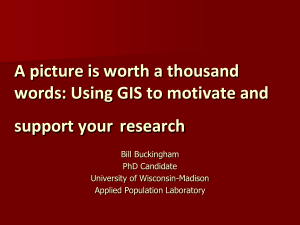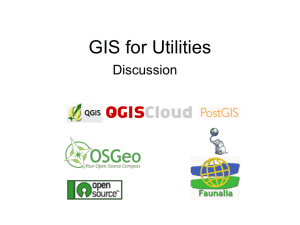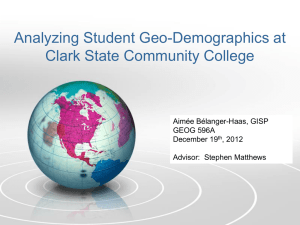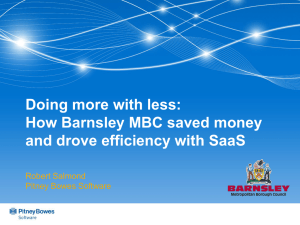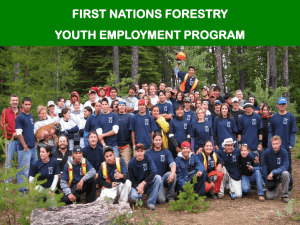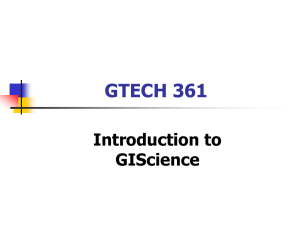PowerPoint - Berry and Associates Spatial Information Systems
advertisement
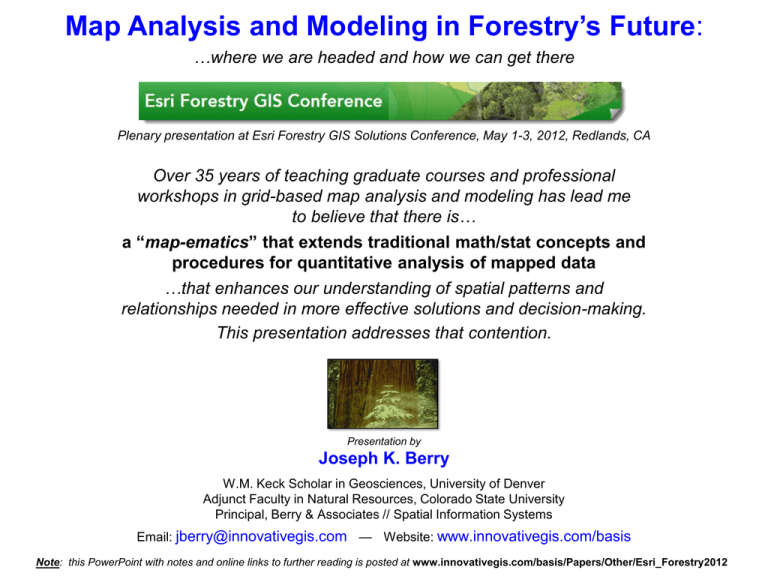
Map Analysis and Modeling in Forestry’s Future: …where we are headed and how we can get there Plenary presentation at Esri Forestry GIS Solutions Conference, May 1-3, 2012, Redlands, CA Over 35 years of teaching graduate courses and professional workshops in grid-based map analysis and modeling has lead me to believe that there is… a “map-ematics” that extends traditional math/stat concepts and procedures for quantitative analysis of mapped data …that enhances our understanding of spatial patterns and relationships needed in more effective solutions and decision-making. This presentation addresses that contention. Presentation by Joseph K. Berry W.M. Keck Scholar in Geosciences, University of Denver Adjunct Faculty in Natural Resources, Colorado State University Principal, Berry & Associates // Spatial Information Systems Email: jberry@innovativegis.com — Website: www.innovativegis.com/basis Note: this PowerPoint with notes and online links to further reading is posted at www.innovativegis.com/basis/Papers/Other/Esri_Forestry2012 Making a Case for SpatialSTEM The lion’s share of the growth has been GIS’s ever expanding capabilities as a “technical tool” for corralling vast amounts of spatial data and providing near instantaneous access to remote sensing images, GPS navigation, interactive maps, asset management records, geo-queries and awesome displays. In just forty years GIS has morphed from boxes of cards passed through a window to a megabuck mainframe that generated page-printer maps, to today’s sizzle of a 3D fly-through rendering of terrain anywhere in the world with back-dropped imagery and semi-transparent map layers draped on top— all pushed from the cloud to a GPS enabled tablet or smart phone. What a ride! However, GIS as an “analytical tool” hasn’t experienced the same meteoric rise— in fact it might be argued that the analytic side of GIS has somewhat stalled over the last decade. Over 35 years of teaching graduate courses and professional workshops in grid-based map analysis and modeling has lead me to believe that there is… a “map-ematics” that extends traditional math/stat concepts and procedures for quantitative analysis of mapped data. The premise is that “maps are numbers first, pictures later” and we do mathematical things to mapped data that moves GIS from “Where is What” graphical inventories to a “Why, So What and What If” problem solving environment— “Thinking with Maps” (Berry) The “-ists” and the “-ologists” Together the “-ists” and the “-ologists” frame and develop the Solution for an application. The “-ists” — and — The “-ologists” …understand the “tools” that can be used to display, query and analyze spatial data …understand the “science” behind spatial relationships that can be used for decision-making Data and Information focus Knowledge and Wisdom focus Application Space Geotechnology’s Core “-ists” Technology Experts Solution Space “-ologists” Domain Experts GIS Expertise Spatial Reasoning Where is What Why, So What, What If (Berry) The “-ists” and the “-ologists” (a bigger tent) Decision Makers utilize the Solution …under Stakeholder, Policy & Public auspices “Policy Makers” “Stakeholders” “Decision Makers” Application Space Geotechnology’s Core “-ists” Technology Experts GIS Expertise We are simultaneously trivializing… Solution Space “-ologists” Domain Experts Spatial Reasoning …and complicating GIS Technology (Berry) Spatial Analysis Operations (Geographic Context) GIS as “Technical Tool” (Where is What) vs. “Analytical Tool” (Why, So What and What if) Grid Layer Map Stack GIS Perspective: Reclassify (Position, Value, Size, Shape, Contiguity) Overlay (Location-specific, Region-wide, Map-wide) Distance (Distance, Proximity, Movement, Optimal Path, Visual Exposure) Neighbors (Characterizing Surface Configuration, Summarizing Values) Map Analysis Toolbox Mathematical Perspective: Basic GridMath & Map Algebra ( + - * / ) Advanced GridMath (Math, Trig, Logical Functions) Map Calculus (Spatial Derivative, Spatial Integral) Map Geometry (Euclidian Proximity, Narrowness, Effective Proximity) Plane Geometry Connectivity (Optimal Path, Optimal Path Density) Solid Geometry Connectivity (Viewshed, Visual Exposure) Unique Map Analytics (Contiguity, Size/Shape/Integrity, Masking, Profile) (Berry) Spatial Analysis Operations (Math Examples) Advanced Grid Math — Math, Trig, Logical Functions Map Calculus — Spatial Derivative, Spatial Integral MapSurface Spatial Derivative 2500 …is equivalent to the slope of the tangent plane at a location The derivative is the instantaneous “rate of change” of a function and is equivalent to the slope of the tangent line at a point 500 Surface Slope draped over MapSurface Fitted Plane SLOPE MapSurface Fitted FOR MapSurface_slope 65% Curve 0% Dzxy Elevation ʃ Districts_Average Elevation Advanced Grid Math Spatial Integral …summarizes the values on a surface for specified map areas (Total= volume under the surface) Surface Area SArea= Fn(Slope) …increases with increasing inclination as a Trig function of the cosine of the slope angle COMPOSITE Districts WITH MapSurface Average FOR MapSurface_Davg MapSurface_Davg cellsize / cos(Dzxy Elevation) The integral calculates the area under the curve for any section of a function. Surface Curve (Berry) Spatial Analysis Operations (Distance Examples) 96.0 minutes Map Geometry — (Euclidian Proximity, Narrowness, Effective Proximity) Plane Geometry Connectivity — (Optimal Path, Optimal Path Density) Solid Geometry Connectivity — (Viewshed, Visual Exposure) Distance Euclidean Proximity …farthest away by truck, ATV and hiking Effective Proximity Off Road Relative Barriers HQ (start) On Road 26.5 minutes Off Road Absolute Barrier …farthest away by truck On + Off Road Travel-Time Surface Farthest (end) Shortest straight line between two points… …from a point to everywhere… …not necessarily straight lines (movement) Rise Run HQ (start) …like a raindrop, the “steepest downhill path” identifies the optimal route Visual Exposure (Quickest Path) Tan = Rise/Run Seen if new tangent exceeds all previous tangents along the line of sight Plane Geometry Connectivity Counts # Viewers Sums Viewer Weights Splash 270/621= 43% of the entire Viewshed road network is connected Highest Exposure (Berry) Spatial Statistics Operations (Numeric Context) GIS as “Technical Tool” (Where is What) vs. “Analytical Tool” (Why, So What and What if) Grid Layer Map Stack GIS Perspective: Surface Modeling (Density Analysis, Spatial Interpolation, Map Generalization) Spatial Data Mining (Descriptive, Predictive, Prescriptive) Map Analysis Toolbox Statistical Perspective: Basic Descriptive Statistics (Min, Max, Median, Mean, StDev, etc.) Basic Classification (Reclassify, Contouring, Normalization) Map Comparison (Joint Coincidence, Statistical Tests) Unique Map Statistics (Roving Window and Regional Summaries) Surface Modeling (Density Analysis, Spatial Interpolation) Advanced Classification (Map Similarity, Maximum Likelihood, Clustering) Predictive Statistics (Map Correlation/Regression, Data Mining Engines) (Berry) Spatial Statistics (Linking Data Space with Geographic Space) Roving Window (weighted average) Geo-registered Sample Data Geographic Distribution Spatial Statistics Discrete Sample Map Non-Spatial Statistics Continuous Map Surface Surface Modeling techniques are used to derive a continuous map surface from discrete point data– fits a Surface to the data (maps the variation). Standard Normal Curve Average = 22.6 In Geographic Space, the typical value forms a horizontal plane implying the average is everywhere to form a horizontal plane StDev = 26.2 Histogram …lots of NE locations exceed Mean + 1Stdev X + 1StDev = 22.6 + 26.2 = In Data Space, a standard normal curve can be fitted to the data to identify the “typical value” (average) 0 10 20 30 40 50 Numeric Distribution 60 70 80 Unusually high values 48.8 X= 22.6 +StDev Average (Berry) Spatial Statistics Operations (Data Mining Examples) Map Clustering: Elevation vs. Slope Scatterplot Cluster 2 Cluster 1 Cluster 2 Cluster 3 Elevation (Feet) Slope draped on Elevation Slope Cluster 1 (Percent) Three Clusters X axis = Elevation (SNV Normalized) Y axis = Slope (SNV Normalized) Data Space Map Correlation: Roving Window Spatially Aggregated Correlation Scalar Value – one value represents the overall nonspatial relationship between the two map surfaces …1 large data table Entire Map Elevation (Feet) with 25rows x 25 columns = 625 map values for map wide summary r= …where x = Elevation value and y = Slope value and n = number of value pairs Slope (Percent) …625 small data tables within 5 cell reach = 81map values for localized summary Localized Correlation Map Variable – continuous quantitative surface represents the localized spatial relationship between the two map surfaces (Berry) Two Clusters Geographic Space The Softer Side of GIS (The NR Experience) Spatial Reasoning, Dialog and Consensus Building Future Directions: Social Acceptability as 3rd filter/rail But Social Acceptability has become the critical third filter needed for successful decision-making. “Regulators” “Publics” “Policy-makers” “Stakeholders” “Decision-makers” Public Involvement Historically Ecosystem Sustainability and Economic Viability have dominated Natural Resources discussion, policy and management. Podium Banquet Table Inter-disciplinary Science Team Table “-ists” 1970s “-ologists” Increasing Social Science & Public Involvement 2010s (Berry) So What’s the Point? 1) Current GIS education in NR for the most part insists that non-GIS students interested in understanding map analysis and modeling must be tracked into general GIS courses that are designed for GIS specialists, and that the material presented primarily focus on commercial GIS software mechanics that GIS-specialists need to know to function in the workplace. 2) However, solutions to complex spatial problems need to engage “domain expertise” in GIS– outreach to other disciplines to establish spatial reasoning skills needed for effective solutions that integrate a multitude of disciplinary and general public perspectives. 3) Grid-based map analysis and modeling involving Spatial Analysis and Spatial Statistics is in large part, simply extensions of traditional mathematics and statistics. 4) The recognition by the GIS community that quantitative analysis of maps is a reality and the recognition by the STEM community that spatial relationships exist and are quantifiable should be the glue that binds the two perspectives. Online Presentation Materials and References www.innovativegis.com/basis/Papers/Other/Esri_Forestry2012/ Handout, PowerPoint and Online References Handout www.innovativegis.com/basis/Papers/Other/Esri_Forestry2012/ …also see www.innovativegis.com/basis, online book Beyond Mapping III Joseph K. Berry — www.innovativegis.com (Berry) Additional Information (live links by slide #) Slide 1, Title – This PowerPoint with notes and live links is posted online at— www.innovativegis.com/basis/Papers/Other/Esri_Forestry2012/ The following links are to the online book Beyond Mapping III posted at www.innovativegis.com Slide 2, Making a Case for SpatialSTEM – Making a Case for SpatialSTEM; A Multifaceted GIS Community; GIS Education’s Need for “Hitchhikers”; Overview of Spatial Analysis and Statistics Slide 3, The “-ists” and the “-ologists” and Slide 4, (A Larger Tent) – Melding the Minds of the “-ists” and “-ologists”; The Softer Side of GIS; Fitting Square Pegs in Round GIS Education Holes Slide 5, Spatial Analysis Operations (Geographic Context) – Simultaneously Trivializing and Complicating GIS; SpatialSTEM Has Deep Mathematical Roots; Understanding Grid-based Data; Suitability Modeling Slide 6, (Math Examples) – Map-ematically Messing with Mapped Data; Characterizing Micro-terrain Features; Reclassifying and Overlaying Maps Slide 7, (Distance Examples) – Calculating Effective Distance and Connectivity; E911 for the Backcountry; Routing and Optimal Paths; Deriving and Using Travel-Time Maps; Deriving and Using Visual Exposure Maps; Creating Variable-Width Buffers; Applying Surface Analysis Slide 8, Spatial Statistics Operations (Numeric Context) – Infusing Spatial Character into Statistics; Paint by Numbers Outside the Traditional Statistics Box Slide 9, (Linking Data Space with Geographic Space) – Spatial Interpolation Procedures and Assessment; Linking Data Space and Geographic Space; Slide 10, (Data Mining Examples) – Characterizing Patterns and Relationships; Analyzing Map Similarity and Zoning Slide 11, The Softer Side of GIS (The NR Experience) – GIS’s Supporting Role in the Future of Natural Resources; Human Dimensions of GIS Slide 12, So What’s the Point? – Is GIS Technology Ahead of Science?; GIS Evolution and Future Trends; Spatial Modeling in Natural Resources _______________________ Additional References: (Links are posted at www.innovativegis.com, “Papers” item) An Analytical Framework for GIS Modeling — white paper presenting a conceptual framework for map analysis and GIS Modeling GIS Modeling and Analysis— book chapter on grid-based map analysis and modeling A Brief History and Probable Future of Geotechnology — white paper on the evolution and future directions of GIS technology
